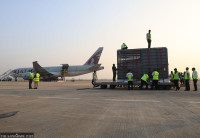Lal Bahadur Dangi, 43, a resident of Madi in Rolpa district, had been working as a porter at the Kalimati fruits and vegetables market in Kathmandu for the past 20 years. After the nationwide lockdown was announced to contain the spread of Covid-19, he stayed in his rented room for a few days, but with every passing day, Dangi began toying with the idea of leaving as he was running out of money.
“I waited for the lockdown to be lifted,” said Dangi. “But I was running out of food. I was worried I would spend all my savings if I stayed in Kathmandu without a job,” said Dang. “I then decided to walk home.”
Dangi reached Ghorahi, Dang on the fifth day of his journey, on Saturday evening. “It was a difficult journey with incomparable pain and suffering,” Dangi told the Post. According to him, he walked all the way from Kathmandu, occasionally hitching rides on trucks.
Like Dangi, 25-year-old Gita Nepali, a resident of Runtigadhi in Rolpa, started walking from Parsa with her six-year-old daughter. Nepali, who worked at a brick kiln in Chainpur, finally decided to head home as the lockdown was extended for the third time. “It took us two days and two nights to reach Ghorahi. It’s been very difficult for me making this journey with my little daughter.”
Along with Dangi and Nepal, 73 others stranded in Dang got on buses heading to Rolpa arranged by Ghorahi Sub-Metropolitan City on Saturday. The 73, most of them daily wage earners, came to Dang from Kathmandu, Pokhara, Sindhupalchok, Dhading, Gorkha, Chitwan and Parsa.
Mayor Narulal Chaudhary said the city decided to arrange vehicles to take the stranded to home. “We still have people coming to Dang on foot to make their way home. We are making arrangements for more vehicles,” he said.
Similarly, various organisations are providing the people walking home food and shelter. The local chapter of Nepal Chamber of Commerce and Industry, various transportation companies, other social organisations and individuals have been providing the local government help to send the migrants home..
As Dang is the gateway for many districts including Rolpa, Rukum, Pyuthan and Salyan, a huge number of people trying to get home have arrived in Dang after the lockdown. According to Ghanshyam Pandey, mayor of Tulsipur Sub-metropolis in Dang, as many as 302 people from various districts arrived in Tulsipur during the last three days alone.
Various local governments in Dang have set up health desks to conduct health checks of those homebound. “We had examined 182 people by Saturday midnight,” said Bimal KC, public health inspector at Tulsipur Sub-metropolis.
Frequently asked questions about the coronavirus outbreak
UPDATED as of September 22, 2020
What is Covid-19?
Covid-19, short for coronavirus disease, is an illness caused by the coronavirus SARS-CoV-2, short for severe acute respiratory syndrome coronavirus 2. Common symptoms of the disease include fever, dry cough, fatigue, shortness of breath and breathing difficulties. In severe cases, the infection can cause pneumonia, severe acute respiratory syndrome, kidney failure and even death.
How contagious is Covid-19?
Covid-19 can spread easily from person to person, especially in enclosed spaces. The virus can travel through the air in respiratory droplets produced when a sick person breathes, talks, coughs or sneezes. As the virus can also survive on plastic and steel surfaces for up to 72 hours and on cardboard for up to 24 hours, any contact with such surfaces can also spread the virus. Symptoms take between two to 14 days to appear, during which time the carrier is believed to be contagious.
Where did the virus come from?
The virus was first identified in Wuhan, China in late December. The coronavirus is a large family of viruses that is responsible for everything from the common cold to Middle East Respiratory Syndrome (MERS) and Severe Acute Respiratory Syndrome (SARS). After an initial outbreak in Wuhan that spread across Hubei province, eventually infecting over 80,000 and killing more than 3,000, new infection rates in mainland China have dropped. However, the disease has since spread across the world at an alarming rate.
What is the current status of Covid-19?
The World Health Organisation has called the ongoing outbreak a “pandemic” and urged countries across the world to take precautionary measures. Covid-19 has spread to 213 countries and territories around the world and infected more than 31,405,983 people with 967,505 deaths and 22,990,260 recoveries. In South Asia, India has reported the highest number of infections at 5,557,573 with 88,943 deaths. While Pakistan has reported 306,304 confirmed cases with 6,420 deaths. Nepal has so far reported 65,276 cases with 427 deaths.
How dangerous is the disease?
The mortality rate for Covid-19 is estimated to be 3.6 percent, but new studies have put the rate slightly higher at 5.7 percent. Although Covid-19 is not too dangerous to young healthy people, older individuals and those with immune-compromised systems are at greater risk of death. People with chronic medical conditions like heart disease, diabetes and lung disease, or those who’ve recently undergone serious medical procedures, are also at risk.
How do I keep myself safe?
The WHO advises that the most important thing you can do is wash your hands frequently with soap and water for at least 20 seconds or use hand sanitizers with at least 60 percent alcohol content. Avoid touching your eyes, nose and mouth with unclean hands. Clean and disinfect frequently used surfaces like your computers and phones. Avoid large crowds of people. Seek medical attention if symptoms persist for longer than a few days.
Is it time to panic?
No. The government has imposed a lockdown to limit the spread of the virus. There is no need to begin stockpiling food, cooking gas or hand sanitizers. However, it is always prudent to take sensible precautions like the ones identified above.





 18.12°C Kathmandu
18.12°C Kathmandu












